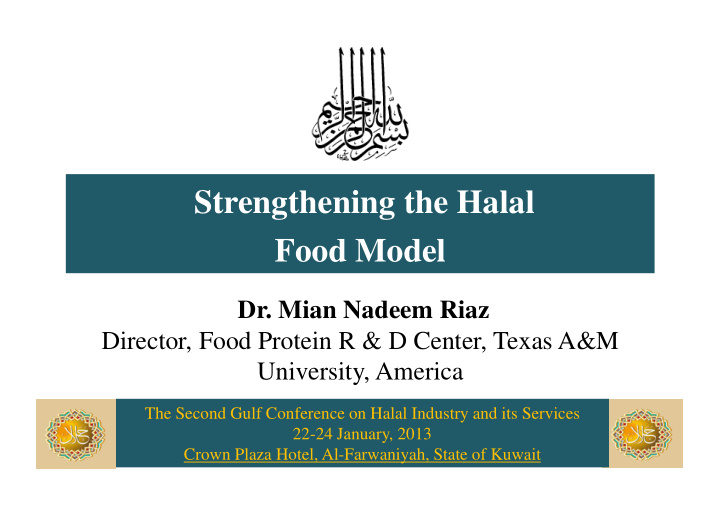



Strengthening the Halal Food Model Dr. Mian Nadeem Riaz Director, Food Protein R & D Center, Texas A&M University, America The Second Gulf Conference on Halal Industry and its Services 22-24 January, 2013 Crown Plaza Hotel, Al - Farwaniyah, State of Kuwait
����� ت��و��� ������ا لو���ا ����د�و ل���ا د . �� ر�ھز ��دو���ا ���ر��ا ������ا ،ءاود�او ءاذ��ا ���ھ ،ر����� �����ا ر��ؤ� �����ا����د�و ل !�ا �"��#� 22-24 ر���� 2013 قد�%از � ناور( – ���اور)�ا – ت�و(�ا ��ود
Models for Halal Food Industry � Several Halal food models exist for different country � Some of the Halal food models are based on import and export requirements � Some of the Halal food models are based on different school of thoughts � Some of the Halal food models got modified because of each countries internal regulations
Some of the Main Differences in Halal Model � Halal verification with lab. analysis vs. Halal traceability via certification � Stunning vs. non stunning meat � Gelatin from different sources � Colors from different insects � Alcohol levels in food
Some of the Main Differences in Halal Model � Stunning vs. non stunning meat � Gelatin from difference sources � Colors from different insects
Some of the Main Differences in Halal Model � Alcohol levels in food Alcohol Permitted in Food (%) Country Alcohol (%) Malaysia (JAKIM) 0.01 Indonesia (MUI) 1.0 Thailand (AOI) 1.0 Singapore (MUIS) 0.5 Brunei (BIRC) 0.0 Europe <0.5 UK Not allowed Canada Not allowed
Indonesian & Malaysia Halal Model Farm Must be performed by a Muslim, animal must be alive at time of slaughter, bleeding must me complete, the trachea Raw Materials Processing and esophagus must be severed, and stunning techniques may be used according to guidelines. Ingredients and Handling Additives Handling Processing Unit Operations Must have a certified Packaging Halal label on package Storage Transportation Distribution Consumption
United Arab Emirates Halal Model Farm Ritual slaughter must take place Raw Materials Processing and be performed by a Muslim in no name other than God. Must not be contaminated by Ingredients & blood or alcohol, pork by- Handling Additives products or other haram ingredients. Handling Processing Unit Operations Certificate must accompany products Packaging labeled Halal, same for fresh/frozen unprocessed product. Storage Transportation Distribution Consumption
Australian Halal Model Farm The act must not be carried out in front of other animals, animal must be free from disease, knife Raw Materials Processing must be extremely sharp and not raised until the cut is complete, cut must be conducted manually. Unless verified Halal, avoid: animal fat or protein, Ingredients anti-oxidants, dairy products, emulsifiers, Handling and Additives flavoring agents, gelatin, glycerin, vitamins, L- Cysteine and other amino acids. Handling Processing Unit Must have a Operations Packaging certified Halal label. Storage Transportation Distribution Consumption
Halal Application Halal Program Process review, Certification Sanitation Review, Facility Audit Ingredient review, Process Physical Audit Review Meeting Flowchart Process Ingredient Recommendation Replacement Approval of Facility Product Review Process Review Production Facility Audit Total Process Records to the Yearly Agency Certificates Record verification Batch certificate issued
Step by Step Approach � We need to review each model � Find major differences in these models � Technical and religious scholar need to discuss these differences � Agreed on one common model
Step by Step Approach It is easy to say then agreed on one common point
Halal Model Religious Technical Knowledge Knowledge
Religious Knowledge One of the major breakthrough for Halal came from • Biotechnology Bovine rennet produced from calves • Not accepted by most Muslims • Whereas chymosin (the main enzymes found in rennet) • produced microbially through transcription from the bovine chymosin gene is universally accepted by Muslims.
Producer Species - HCCP1: Halal Breeding Animal HCCP2: Livestock Animal Farming Welfare HCCP3: Stunning HCCP4: Knife HCCP5: Slaughter Slaughter Process Person HCCP6: Slaughter Method HCCP7: Invocation HCCP8: Control of Raw Materials Meat HCCP9: Processing Storage HCCP10: Packaging, Labelling HCCP:11 Retailing Halal Meat Outlet Consumer
Halal Auditors and Management Competency Halal Certifying Bodies Approx. # Australia & New Zealand 20 Africa 9 Asia 22 Europe 40 North America 14 South America 6 Total 111
Halal Auditors and Management Competency � How many of these certifying bodies have food scientist or technologist on their staff with professional degree from universities � How many of these certifying bodies have panel of religious scholar to discuss Halal related issue on a daily basis � How many of these certifying bodies provide training to their inspector on routine basis
Halal Auditors and Management Competency � How many of these certifying bodies visit food processing facilities for Halal inspection on yearly basis � How many of these certifying bodies have their website to provide information to the consumer � How many of these certifying bodies have their Halal standards on their website to help food industries
Halal Auditors and Management Competency � How many of these certifying bodies hold seminar and conference to provide information to Muslim and non-Muslim regarding Halal foods � How many inspectors from these certifying bodies get training for animal handling and slaughtering
Accreditation of Halal Certifying Bodies � According to my information very few HCB are accredited by third parties
Halal Certification Food formula Review arrives for review Look for Look for alcohol origin animal origin ingredient ingredient have been have been Alcohol Animal used used Halal Certificate
Recommend
More recommend